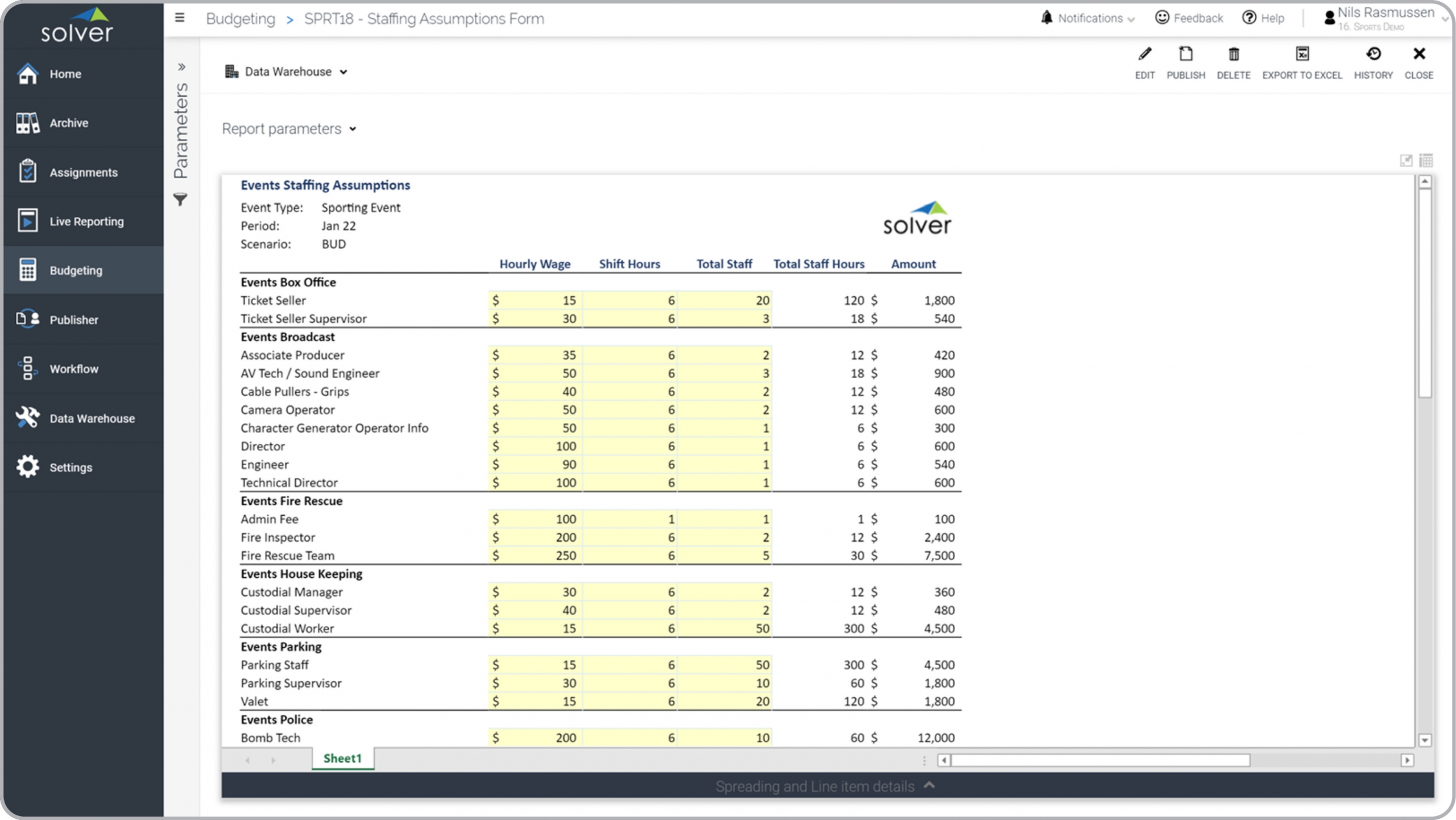Event Staffing Budget for Venues and Professional Sports Teams
What is an
Event Staffing Budget
? Staffing budgets are considered human capital planning tools and are used by budget managers to automate staffing and payroll calculations in event budgets. Some of the main functionality in this type of input form is that it can be used for any event/game to capture staff cost and drivers like: Hourly wages, shift hours, total staff FTEs. The rows in the input form shows examples of types of staff like ticket box office, parking, etc. This form is used as a component of a complete event budget model for a venue(s). You find an example of this type of input form below.
Purpose of
Event Staffing Budgets Venues and Sports organizations use Event Staffing models to automate and simplify the staffing component of an event budget. When used as part of good business practices in Financial Planning & Analysis (FP&A) departments, an organization can improve its budget accuracy and increase revenues by optimizing event planning, and it can reduce the chances that inaccurate budgets leads to over- or under-staffing of events.
Example of an
Event Staffing Budget Here is an example of an Event Staffing input model with web-based data capture. [caption id="" align="alignnone" width="2560"]
 Example of an Event Staffing Budget for Venues and Professional Sports Teams[/caption] You can find hundreds of additional examples
here
Who Uses This Type of
Input form
? The typical users of this type of input form are: CFOs, budget managers, event managers, staffing managers.
Other Reports Often Used in Conjunction with
Event Staffing Budgets Progressive Financial Planning & Analysis (FP&A) departments sometimes use several different Event Staffing models, along with revenue budgets, other expense budget forms, profit & loss budgets, event dashboards, actual versus budget variance reports and other management and control tools.
Where Does the Data for Analysis Originate From? The Actual (historical transactions) data typically comes from enterprise resource planning (ERP) systems like: Microsoft Dynamics 365 (D365) Finance, Microsoft Dynamics 365 Business Central (D365 BC), Microsoft Dynamics AX, Microsoft Dynamics NAV, Microsoft Dynamics GP, Microsoft Dynamics SL, Sage Intacct, Sage 100, Sage 300, Sage 500, Sage X3, SAP Business One, SAP ByDesign, Acumatica, Netsuite and others. In analyses where budgets or forecasts are used, the planning data most often originates from in-house Excel spreadsheet models or from professional corporate performance management (CPM/EPM) solutions.
What Tools are Typically used for Reporting, Planning and Dashboards? Examples of business software used with the data and ERPs mentioned above are:
Example of an Event Staffing Budget for Venues and Professional Sports Teams[/caption] You can find hundreds of additional examples
here
Who Uses This Type of
Input form
? The typical users of this type of input form are: CFOs, budget managers, event managers, staffing managers.
Other Reports Often Used in Conjunction with
Event Staffing Budgets Progressive Financial Planning & Analysis (FP&A) departments sometimes use several different Event Staffing models, along with revenue budgets, other expense budget forms, profit & loss budgets, event dashboards, actual versus budget variance reports and other management and control tools.
Where Does the Data for Analysis Originate From? The Actual (historical transactions) data typically comes from enterprise resource planning (ERP) systems like: Microsoft Dynamics 365 (D365) Finance, Microsoft Dynamics 365 Business Central (D365 BC), Microsoft Dynamics AX, Microsoft Dynamics NAV, Microsoft Dynamics GP, Microsoft Dynamics SL, Sage Intacct, Sage 100, Sage 300, Sage 500, Sage X3, SAP Business One, SAP ByDesign, Acumatica, Netsuite and others. In analyses where budgets or forecasts are used, the planning data most often originates from in-house Excel spreadsheet models or from professional corporate performance management (CPM/EPM) solutions.
What Tools are Typically used for Reporting, Planning and Dashboards? Examples of business software used with the data and ERPs mentioned above are:
- Native ERP report writers and query tools
- Spreadsheets (for example Microsoft Excel)
- Corporate Performance Management (CPM) tools (for example Solver)
- Dashboards (for example Microsoft Power BI and Tableau)
Corporate Performance Management (CPM) Cloud Solutions and More Examples
June 15, 2021
TAGS:
Reporting,
Solver,
NPSL,
report writer,
Microsoft,
NBA,
template,
practice,
Acumatica,
basketball,
league,
expenses,
MLB,
Netsuite,
Finance,
planning,
GP,
Business Central,
excel,
professional,
ax,
Sports,
forecast,
Budget,
Dynamics 365,
budgeting,
professional sports,
payroll budget,
Cloud,
Software,
Tableau,
SAP,
NRL,
example,
NHL,
NFL,
best,
Sage,
BC,
EPL,
D365,
MLS,
NAV,
Intacct,
soccer,
hockey,
baseball,
CPM,
report,
SL,
Management,
dynamics,
football,
Power BI,
forecast driver,
game,
event,
assumptions,
staff budget

